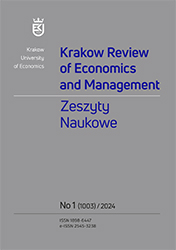Wielowymiarowa analiza dyskryminacyjna jako instrument oceny zagrożenia upadłością przedsiębiorstw należących do indeksu WIG-spożywczy
Multidimensional Discriminant Analysis
as an Instrument for Assessing the Risk
of Bankruptcy of WIG-food Index Enterprises
Author(s): Chrystian Bernard Firlej, Krzysztof FirlejSubject(s): Business Economy / Management, Health and medicine and law, Financial Markets, Socio-Economic Research
Published by: Wydawnictwo Uniwersytetu Ekonomicznego w Krakowie
Keywords: Warsaw Stock Exchange; WIG-food index; discriminatory analysis; financial cooperation; COVID-19 pandemic;
Summary/Abstract: Objective: To assess the financial situation of selected enterprises included in the WIG-food index in 2019–2021 from the point of view of the risk of bankruptcy.Research Design & Methods: Four models of multidimensional discriminatory analysis were used to assess potential bankruptcy risk (Dorota Hadasik’s Model, Model Z6 INE PAN, Model Z7 INE PAN and the so-called Poznań Model). The entities selected for the study were all Polish companies traded on the WIG-food index in all quarters of the years 2019–2021. This condition had to be met due to the volatility of the composition of the WIG-food index on a quarterly basis (quarterly revision of the index portfolio). Two research hypotheses were formulated in the article. First, selected discriminant analysis models are an effective tool for assessing companies included in the WIG-food index for the risk of bankruptcy. And second, multidimensional discriminant analysis is a valuable and complementary tool to other methods of assessing the risk of company bankruptcy.Findings: Companies included in the WIG-food index in 2019–2021 were in a very good financial situation with the exception of two companies, which faced the threat of bankruptcy in 2019: ZPC Otmuchów SA and Pamapol SA. Three of the models used indicated that the companies were moving in the wrong direction: Z6 INE PAN and Z7 INE PAN (ZPC Otmuchów SA) and the Poznań Model (Pamapol SA). This may suggest that these models were highly sensitive. Hadasik’s Model did not show any company to be at risk of bankruptcy in the analysed period. Implications/Recommendations: One implication of the research is that the number of variables in discriminant analysis models does not work to exaggerate their efficiency. Two of the models used (Z6 INE PAN and Z7 INE PAN) returned similar results. This is mainly due to their being constructed similarly. Furthermore, none of the selected models showed high sensitivity to detecting the threat of bankruptcy among the companies analysed, though they could be used to faster warn about potential and actual problems.Contribution: The research contributes to the development of knowledge on the use of discrim- inatory analysis models to assess bankruptcy risk of food industry enterprises in Poland.
Journal: Zeszyty Naukowe Uniwersytetu Ekonomicznego w Krakowie
- Issue Year: 1003/2024
- Issue No: 1
- Page Range: 117-136
- Page Count: 20
- Language: Polish

